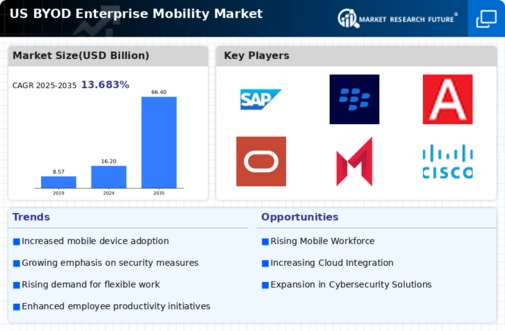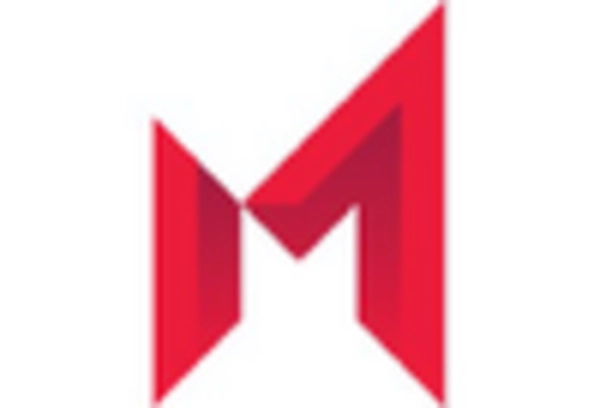Increased Adoption of Cloud-Based Solutions
The shift towards cloud-based solutions is significantly influencing the byod enterprise-mobility market. Organizations are increasingly leveraging cloud technologies to facilitate remote access to applications and data, thereby enhancing the functionality of BYOD policies. This trend is supported by the fact that cloud adoption in the enterprise sector has reached approximately 80%, indicating a strong preference for scalable and flexible IT solutions. As businesses continue to embrace cloud services, the byod enterprise-mobility market is expected to grow, driven by the need for seamless integration between personal devices and cloud applications.
Rising Demand for Flexible Work Arrangements
the market is experiencing a notable surge in demand for flexible work arrangements.. Organizations are increasingly recognizing the benefits of allowing employees to use personal devices for work purposes. This trend is driven by the desire for improved work-life balance and enhanced employee satisfaction. According to recent data, approximately 70% of employees express a preference for flexible work options, which has prompted companies to adopt BYOD policies. This shift not only boosts productivity but also reduces operational costs associated with providing company-owned devices. As a result, the market is likely to expand as more businesses implement strategies to accommodate this growing demand..
Growing Emphasis on Data Security and Privacy
In the current landscape, the emphasis on data security and privacy is becoming increasingly pronounced within the byod enterprise-mobility market. Organizations are acutely aware of the risks associated with data breaches and unauthorized access to sensitive information. As a result, many are investing in robust security measures to protect corporate data accessed through personal devices. A recent survey revealed that 60% of companies have heightened their security budgets to address these concerns. This growing focus on data protection is likely to drive the adoption of BYOD policies, as businesses seek to balance flexibility with the need for stringent security protocols.
Evolving Workforce Demographics and Preferences
The changing demographics of the workforce are reshaping the byod enterprise-mobility market. Younger generations, particularly millennials and Gen Z, are entering the workforce with a strong inclination towards using personal devices for work-related tasks. This demographic shift is prompting organizations to adapt their policies to align with employee preferences. Research indicates that nearly 75% of younger employees prefer to use their own devices, which has led to an increase in BYOD implementations. Consequently, the byod enterprise-mobility market is likely to expand as companies recognize the importance of catering to the evolving preferences of their workforce.
Advancements in Mobile Device Management Solutions
The evolution of mobile device management (MDM) solutions plays a crucial role in shaping the byod enterprise-mobility market. With the increasing complexity of managing diverse devices, organizations are turning to advanced MDM solutions to ensure security and compliance. These solutions enable IT departments to monitor, manage, and secure personal devices used for work. Recent statistics indicate that the MDM market is projected to grow at a CAGR of 25% over the next five years, reflecting the rising need for effective management tools. Consequently, the byod enterprise-mobility market is likely to benefit from the integration of sophisticated MDM technologies that enhance security and streamline operations.

















Leave a Comment